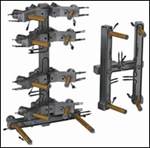The Mold Shop Puzzle, Creating Constructive Change: Lean
The first and hardest step in the lean process is recognizing that your perfectly functioning shop can be improved.
Lean manufacturing has been a buzz phrase since the mid 1960s. Lean initiatives have been something most mold shops historically have ignored or believed would be a waste of time. Many shop owners have stated over and over that lean only applies to repetitive functions or production facilities. The simple fact is that incorporating lean is one decision that can add the most to any shop’s margin. The first and hardest step in the lean process is recognizing that your perfectly functioning shop can be improved.
The mere mention of lean initiatives sends chills through most mold shops. The labels and names of lean initiatives cause confusion and place a barrier to the changes that can save their jobs. The words Kaizen, Six Sigma, 5S and Value Stream Mapping are viewed as foreign, and often strike fear on the shop floor because most shops are focused on getting the work they have out the door and are not worried about these functions, which can lead to improvements.
There are many different approaches to implementing lean procedures. You can implement the 5S process that swept to popularity by Toyota, which is about cleaning up the shop, labeling and maintaining an atmosphere of organization. As easy as it sounds and as common sense as it should be, shops resist the simple techniques that will save their process time and money.
When attempting to implement any type of the 5S process the parade of excuses starts and suddenly the initiatives fail because of the weight of the protests. 5S stands for “Sort, Set, Shine, Standardize and Sustain,” and the process follows those words.
When touring a shop it is easy to identify clutter and the areas in need of organization. The common excuse is, “We’ll be using this device soon, so I don’t need to put it in a different spot.” The easiest rule of thumb for putting items away is: If you are not using it at least once an hour, it should have a place other than on your work bench.
Time saved from the Easter Egg Hunt that occurs as workers search for fixtures, cutters, sineplates and clamping devices can be eliminated if everything is given a proper place. That encompasses the first two parts of 5S—sorting and setting. The rest of 5S is to clean up, and standardize where and how you do things. Followed by the most difficult part: sustain what you have just put into order.
By implementing Kaizen—which is Japanese for improvement—you can have periodic events where the entire shop identifies areas and processes that require extra movements. This should be led by someone on the shop floor and works well in conjunction with a 5S process.
The unfounded fear that Value Stream Mapping sends through a shop can be eliminated as you implement a 5S evolution and Kaizen events to eliminate repetitive events or more movements than necessary. This then causes you to rethink how the shop is actually set up—possibly requiring moving machines and reworking the process flow. For example, if you look at how much time it takes for an engineer to walk from their office to where engineering changes are occurring on the shop floor, you may decide to move the engineering office to minimize the time spent just walking around.
True lean can be tackled in as many ways as there are mold shops, but to ignore trying to implement some kind of lean or to not eliminate waste is like leaving money on the floor.
Related Content
Predictive Manufacturing Moves Mold Builder into Advanced Medical Component Manufacturing
From a hot rod hobby, medical molds and shop performance to technology extremes, key relationships and a growth strategy, it’s obvious details matter at Eden Tool.
Read MoreWomen Impacting Moldmaking
Honoring female makers, innovators and leaders who are influencing our industry's future.
Read MoreEditorial Guidelines: Editorial Advisory Board
The Editorial Advisory Board of MoldMaking Technology is made up of authorities with expertise within their respective business, industry, technology and profession. Their role is to advise on timely issues, trends, advances in the field, offer editorial thought and direction, review and comment on specific articles and generally act as a sounding board and a conscience for the publication.
Read MoreFrom Injection Mold Venting to Runnerless Micro Molds: MMT's Top-Viewed June Content
The MoldMaking Technology team has compiled a list of the top-viewed June content based on analytics. This month, we covered an array of topics including injection mold venting, business strategies and runnerless micro molds. Take a look at what you might have missed!
Read MoreRead Next
Lean Manufacturing Trims Leadtimes
Moldmakers aren't the only ones reducing leadtimes. Component and hot runner suppliers are delivering their equipment and supplies faster to accommodate industry demand.
Read MoreHow to Use Strategic Planning Tools, Data to Manage the Human Side of Business
Q&A with Marion Wells, MMT EAB member and founder of Human Asset Management.
Read MoreAre You a Moldmaker Considering 3D Printing? Consider the 3D Printing Workshop at NPE2024
Presentations will cover 3D printing for mold tooling, material innovation, product development, bridge production and full-scale, high-volume additive manufacturing.
Read More



.png;maxWidth=300;quality=90)







_300x250 1.png;maxWidth=300;quality=90)










.jpg;maxWidth=970;quality=90)